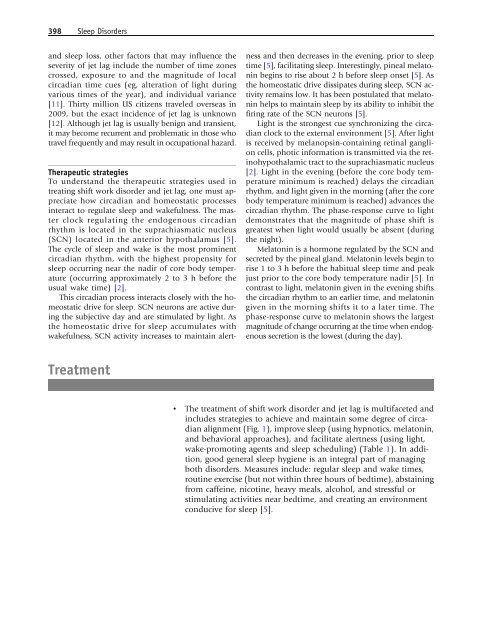SHIFT WORK DISORDER - myCME.com
SHIFT WORK DISORDER - myCME.com
SHIFT WORK DISORDER - myCME.com
- No tags were found...
Create successful ePaper yourself
Turn your PDF publications into a flip-book with our unique Google optimized e-Paper software.
398 Sleep Disordersand sleep loss, other factors that may influence theseverity of jet lag include the number of time zonescrossed, exposure to and the magnitude of localcircadian time cues (eg, alteration of light duringvarious times of the year), and individual variance[11]. Thirty million US citizens traveled overseas in2009, but the exact incidence of jet lag is unknown[12]. Although jet lag is usually benign and transient,it may be<strong>com</strong>e recurrent and problematic in those whotravel frequently and may result in occupational hazard.Therapeutic strategiesTo understand the therapeutic strategies used intreating shift work disorder and jet lag, one must appreciatehow circadian and homeostatic processesinteract to regulate sleep and wakefulness. The masterclock regulating the endogenous circadianrhythm is located in the suprachiasmatic nucleus(SCN) located in the anterior hypothalamus [5].The cycle of sleep and wake is the most prominentcircadian rhythm, with the highest propensity forsleep occurring near the nadir of core body temperature(occurring approximately 2 to 3 h before theusual wake time) [2].This circadian process interacts closely with the homeostaticdrive for sleep. SCN neurons are active duringthe subjective day and are stimulated by light. Asthe homeostatic drive for sleep accumulates withwakefulness, SCN activity increases to maintain alertnessand then decreases in the evening, prior to sleeptime [5], facilitating sleep. Interestingly, pineal melatoninbegins to rise about 2 h before sleep onset [5]. Asthe homeostatic drive dissipates during sleep, SCN activityremains low. It has been postulated that melatoninhelps to maintain sleep by its ability to inhibit thefiring rate of the SCN neurons [5].Light is the strongest cue synchronizing the circadianclock to the external environment [5]. After lightis received by melanopsin-containing retinal ganglioncells, photic information is transmitted viatheretinohypothalamictract to the suprachiasmatic nucleus[2]. Light in the evening (before the core body temperatureminimum is reached) delays the circadianrhythm, and light given in the morning (after the corebody temperature minimum is reached) advances thecircadian rhythm. The phase-response curve to lightdemonstrates that the magnitude of phase shift isgreatest when light would usually be absent (duringthe night).Melatonin is a hormone regulated by the SCN andsecreted by the pineal gland. Melatonin levels begin torise 1 to 3 h before the habitual sleep time and peakjust prior to the core body temperature nadir [5]. Incontrast to light, melatonin given in the evening shiftsthe circadian rhythm to an earlier time, and melatoningiven in the morning shifts it to a later time. Thephase-response curve to melatonin shows the largestmagnitude of change occurring at the time when endogenoussecretion is the lowest (during the day).Treatment&The treatment of shift work disorder and jet lag is multifaceted andincludes strategies to achieve and maintain some degree of circadianalignment (Fig. 1), improve sleep (using hypnotics, melatonin,and behavioral approaches), and facilitate alertness (using light,wake-promoting agents and sleep scheduling) (Table 1). In addition,good general sleep hygiene is an integral part of managingboth disorders. Measures include: regular sleep and wake times,routine exercise (but not within three hours of bedtime), abstainingfrom caffeine, nicotine, heavy meals, alcohol, and stressful orstimulating activities near bedtime, and creating an environmentconducive for sleep [5].
















